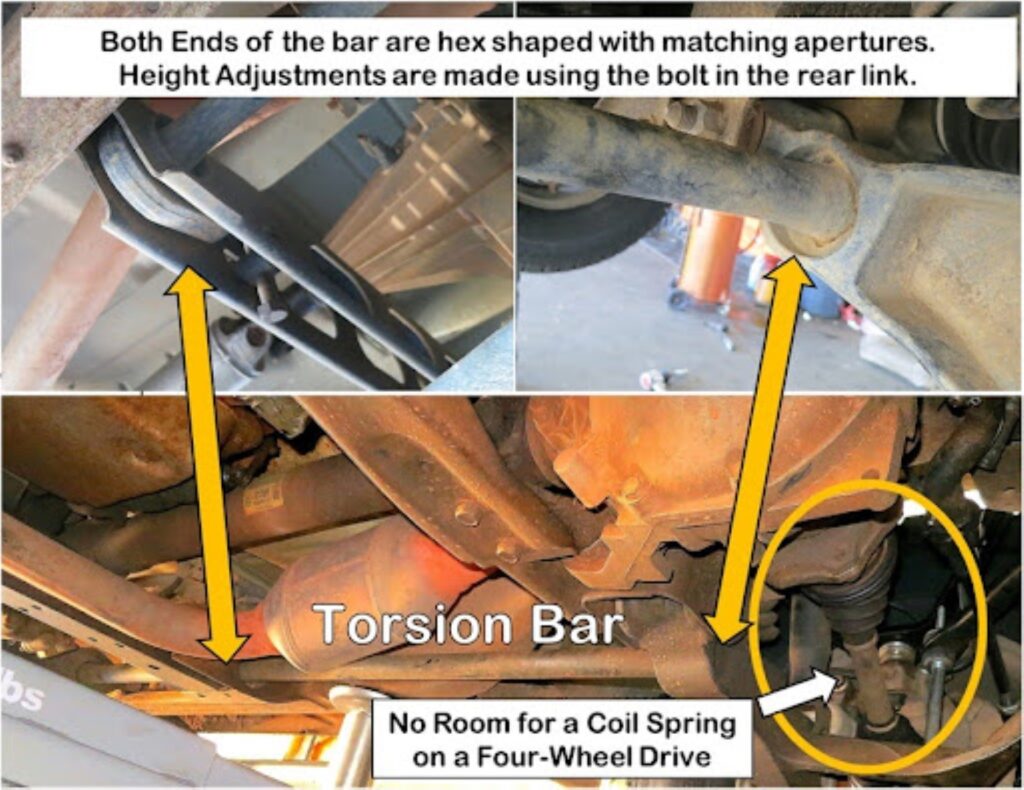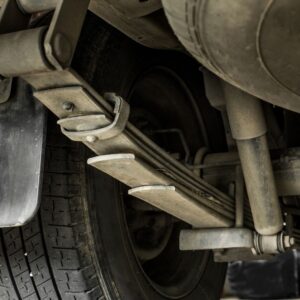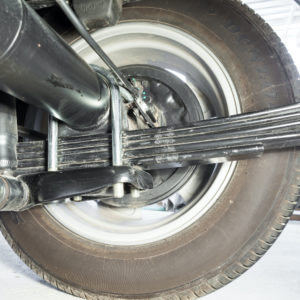How does a torsion bar suspension work? What about leaf springs and coil spring suspensions? Your vehicle relies on these suspension spring types to keep your daily drives as smooth and comfortable as possible. But what differences do these spring types make, and what does it mean if your vehicle uses one or the other? Let’s take a look at these suspension spring types to find out.
Suspension Spring Basic Functions
All types of suspension springs serve a similar purpose. When your vehicle hits a bump on the road, the suspension system absorbs that kinetic energy, keeping the tires on the ground despite the jolt. Much of that is thanks to the suspension springs.
The suspension springs produce recoil for your vehicle’s suspension system. When the kinetic energy travels through the suspension system, the springs compress momentarily. They then return the energy to the road through recoil. Thanks to their recoil, the springs keep the wheels on the road while also preventing most of that kinetic energy from reaching the cabin and the vehicle’s passengers. The springs keep the wheels aligned too, adjusting them accordingly as the road surface changes.
All suspension springs also have a spring rate, which is the amount of force necessary to compress the spring by an inch. Springs with spring rates of 250 lb/in will exert 200 lbs of force back if you compress them by an inch. Higher spring rates reduce the vehicle’s body roll and lean but produce a stiffer feel. Lower spring rates produce more grip and make it easier to travel over bumps.
What Are Torsion Bars?

Torsion bar suspensions are far less common these days except on Chevy four-wheel-drive trucks and SUVs up to 2019. Ford shifted away from Torsion Bars in 2003 and Dodge RAM stopped using torsion bars in 2009.
Manufacturers have shifted to using coil and leaf springs in recent years, leaving torsion bar suspension systems for more specialized machines like modern combat and racing vehicles.
You can still find them on many classic vehicles, such as older Volkswagen Beetles and Microbuses.
Torsion bars dampen vehicle loads and bumps on the road by twisting. These bars are steel tubes that mount lengthwise to the suspension’s control arms and the chassis via hex-shaped or splined attachments. As the vehicle travels, the end attached to the chassis stays stationary. The other end connected to the control arm twists along the bar’s axis when the vehicle’s wheels move up and down.
Due to their length and the way torsion bars mount onto the suspension system, they allow for more wheel travel on four-wheel-drive vehicles. There’s a torsion key at the torsion bar’s fixed end on the chassis. This anchor point is a lever that both holds the bar at a set height and keeps it attached to the vehicle’s frame. Adjusting the torsion key position raises or lowers the vehicle’s ride height.
A torsion bar’s thickness, diameter, raw materials, and length determine its spring rates.
Advantages and Disadvantages
Many enthusiasts praise torsion bars for their durability and dependability. These types of suspension springs need little to no maintenance. More than that, they’re adjustable, thanks to the torsion key and adjusting bolt.

Twisting the bolt changes the key, which in turn adds or releases a twist in the bar. This allows you to change the vehicle’s ride height, which is a huge deal for many enthusiasts who want a quick and easy way to do so.
Unfortunately, torsion bars have gone out of fashion for a reason. They have fixed spring rates, meaning drivers have to choose between performance or comfort and can’t change that on the fly. Also, as reliable as they are, torsion bars are vulnerable to debris and obstacles, often placing strain on other components. The bar is prone to breaking under stress even with small nicks on the metal if it’s in a vulnerable position.
Signs of Wear
If your vehicle has a torsion bar suspension system, you’ll know something’s wrong when it starts sagging. In addition, you might notice that rides are a little bumpier than usual and there’s a metallic squeak coming from underneath your vehicle.
What Are Suspension Coil Springs?
Suspension coil springs look a lot like generic coil springs. They’re thick, metal wires coiled into a helical shape that compress and extend as load is placed on or removed from them. MacPherson struts have coil springs mounted around the shock absorbers, but for vehicles without struts, coil springs and shock absorbers mount separately. Coil springs sometimes ride on top of the vehicle’s axle instead.
Advantages and Disadvantages
Because of how coil springs store and release kinetic energy through movement, manufacturers usually install them on performance vehicles and trucks. Off-road vehicles also benefit from coil springs due to the uneven ground when off roading. Off-road vehicles need a suspension system that can frequently rise and fall as it adjusts to the ever-changing road.
Unfortunately, coil spring suspensions tend to cost more than leaf spring systems, and they’re bad at handling heavier loads from heavy vehicles.
Signs of Wear
If your vehicle’s suspension coil springs are inoperative or faulty, you might notice sagging, unusual tire wear, harsh vehicle bounce, abrupt swaying, and unsettling noises coming from the suspension system.
What Are Leaf Springs?
Leaf springs get their name from their shape. They’re made up of long, thin, narrow metal plates that curve in an arc. The plates stack lengthwise with a bolt securing them together at the center. Mono-leaf springs have only a singular spring while multi-leaf springs have two plates or more. They attach to both ends of the rear axle. Many manufacturers use leaf springs in tandem with other suspension types. Leaf springs often support a vehicle’s rear while coil springs support its front.
Advantages and Disadvantages
Leaf springs are very common thanks to their straightforward function, less complicated design, and load-bearing qualities. They’re excellent in stop-and-go traffic because they help the vehicle better absorb the shock of frequently engaged brakes. Leaf springs also absorb smaller up and down and side to side motions more, such as the motions from driving over gravel. They’re cheaper than coil springs and can carry more weight.
All that being said, leaf springs do have their drawbacks. They’re not as flexible as coil springs, meaning that on more difficult terrain, they have a more difficult time connecting the wheels to the ground on a bad bump. It’s also hard to adjust these springs because of how firmly they attach to the chassis. In addition, while they can carry heavier loads, they sink more than coil springs when doing so.
Signs of Wear
Signs of bad leaf springs include abnormal undercarriage noises, sagging, the rear tires going off center, and visible damage on the springs themselves.
And there you have it! You now know how coil springs, leaf springs, and torsion bars work. Knowing the differences between these suspension springs is important for understanding how the suspension system as a whole functions. You can thank them for taking the hit the last time you drove over any potholes or bumps on the road.
Order Replacement Coil Springs and Leaf Springs From Your Home
Whether the transmission uses coil springs or leaf springs, you must replace the suspension springs once they wear out or fail. Otherwise, you might damage other suspension parts, adding to the labor and repair cost of fixing your vehicle. Fortunately, you don’t have to leave home to get new coil springs and leaf springs, as you can order them online from CarParts.com.
Enjoy shopping for affordable, reliable coil springs and leaf springs online at CarParts.com. We understand the importance of parts that fit your car, so we make it easy to find compatible suspension springs. All you need are your vehicle’s year, make, model, and engine. Plug the relevant information in our website’s built-in vehicle selector and browse our wide selection of automotive parts from industry veterans trusted by many drivers. Our nearest distribution center will ship your new coil springs or leaf springs to your doorstep. If you live in the continental US and order before noon ET, your order can arrive in several business days.
What are you waiting for? Order a new coil spring or leaf spring at CarParts.com today!
Any information provided on this Website is for informational purposes only and is not intended to replace consultation with a professional mechanic. The accuracy and timeliness of the information may change from the time of publication.
































